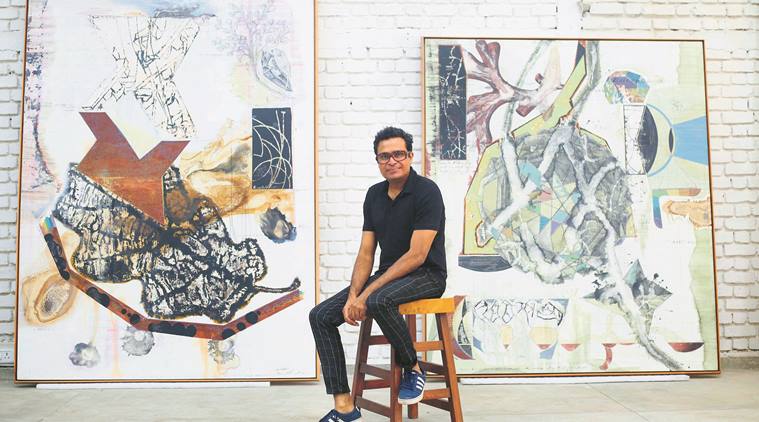Written by Pooja Pillai |Published: January 4, 2019 12:09:50 am
What Drew the Line?
In Jitish Kallat’s return to painting is a continuation of a long-standing preoccupation: what happens when an artist allows forces external to himself to guide his work.

Is it possible for the artist, who is trained by habit into certain attitudes before the canvas, to drop out of them and start afresh? Can he let his material guide his hand, and allow it to announce its autonomy to generate form and image and, hopefully, create a meaning in the mind of the viewer? These were some of the questions that Jitish Kallat asked himself as he returned to painting last year, after a hiatus of five years. “I wanted to paint by dropping the muscle memory of how I have actually touched a canvas previously, just so that I could drop the predictable responses I would get from them. When you stand in front of an 8ft x 6ft canvas, especially, there is a particular posture with which you begin, and I just wanted to paint in a way that would allow me to stay committed to many of the questions that I ask myself as an artist, but at the same time see if I could be pushed to think through the paint,” says Kallat. It’s not like there was an image or a thought that could be articulated verbally, which he wanted to put on the canvas. “The pigment had to generate everything from itself,” he says, “how the various elements interact with each other, how they hydrate or dehydrate, how the paint glides or drips, the kind of imagery that can be created simply from the movement of the pigment across the canvas. It would be formed by a certain turbulence on the surface of the work, a bit like the push and pull of weather or atmospheric turbulence.”
The works — Palindrome/Anagram paintings — that emerged from this self-interrogation will be on view in Kallat’s third solo exhibition in Paris at Galerie Templon from January 12. And while it might seem like they represent a break from the 44 year old’s existing body of work, they are actually a continuation of the explorations that have pushed Kallat through his over two decade long career. For example, the idea that the artist might surrender the direction of his work to external forces, was explored in works like his Rain Study and Wind Study series. In the former, graphs drawn with watercolour pencils were exposed to the rain and as each drop hit a line of colour, it released the pigment from its confines, allowing it to bloom on the paper. In the suite of works titled ‘Wind Study (Hilbert Curve) Series’, on the other hand, a line made with flammable material on paper was lit up and exposed to the vagaries of the outdoors, with the flame bending to even the most imperceptible shift in air currents and leaving behind scorch marks. Such a letting go, says Kallat, was a central part of his return to painting. “If I did it, it would allow me to renew myself. I could work with different postures and gestures. So I knew the entire muscle memory would have to go. It allowed me to find aspects of myself that needed to be manifested in my work,” he says.
Yet, even as the material guided itself into shapes — both recognisable and abstract — Kallat saw something else emerging in each work. A friend of his, he reveals, applied the words “conceptual” and “narrative” to the new paintings and while he had always resisted these tags before, Kallat found himself accepting them this time. He says, “It feels like there’s a dimension of narration in these works which are not verbal or representational narrations, with one form leading to another. For example, a free-moving line of charcoal started to create shapes and boundaries or a flow of water onto stable flat pigment seemed to create some kind of luminosity as if changing dimension from simply liquid to photons.” This intersection of different dimensions — the celestial with the terrestrial, the terrestrial with the corporeal — has long been one of Kallat’s preoccupation. In the 2017 photographic work titled Sightings D7M62017, for example — which will also be on display in Paris — he exposes what look like starfields on the surface of a fruit. The celestial stood revealed on a small piece of the botanical and this intersection of dimensions represents, to the artist, the sublime reality of our very existence. “We are nothing but the perennial manifestation of these conflations of different dimensions,” he explains and adds, “At this moment each of our bodies have millions of atoms that have been in the body of every other species. Every three weeks, a quadrillion atoms go through our bodies, which have been through the body of every species on the planet. So in some ways, while I’m painting, that’s really what I’m seeking: can the painting just let this world go through it? Through a mix of the structured and the structureless, abstraction and form, can the painting really generate its own world?”






















No hay comentarios:
Publicar un comentario